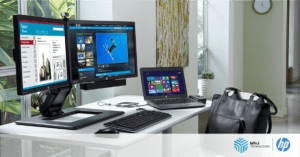Remote working is one of the hottest discussions in business these days. Even as public health officials adjust quarantine guidelines to open states for business, many companies–and many workers–are planning to continue remote working, after discovering benefits beyond public health factors. But there’s definitely a period of adjustment going on as people discover the ins and outs of optimizing their remote workspace. Here are a few tips and tricks for improving your environment.
Managing Distractions
By far the biggest challenge most people report with remote working is staying on task, whether trying to avoid external or internal distractions. External distractions most commonly include kids, pets, noisy housemates, and neighbors. For these kinds of distractions, the best antidotes are all about creating your space–someplace you can get at least 20-minute chunks of time alone, ideally more like 45-90 minutes. If you’re fortunate, you may be able to create a couple of spaces to be alone, maybe one place in a quiet room and another on the patio, but many people make do with a converted closet or even a bathroom.
Internal distractions are often harder, including everything from surfing the web to obsessing over what to have for lunch later. Some of these distractions can be managed with technology. There are productivity tools you can use that block your use of websites for a period of time, allowing you to focus on your work–in extreme cases, you can edit your host’s file to completely block specific URLs. Other distractions, like hunger, take more of a behavioral approach, like snacking wisely between meals and staying hydrated.
The fundamental way to figure out what distractions you really need to manage is to set specific objectives for the day–things you can accomplish that day–and monitor your ability to achieve them. It may take a little time to adjust your expected workload or to account for the things you have to do that you didn’t list, but if you’re paying attention to setting objectives and monitoring your ability to carry them out, you’ll figure out quickly which distractions are getting in your way.
Optimizing Your Technology
As you get into a routine of working in your remote workspace, you’ll start to see the strengths and weaknesses of the devices that support your productivity. If you move around a lot from space to space in your environment, having a lighter-weight laptop that moves with you is liberating. On the other hand, feeling your entire remote workspace crammed into a small laptop screen can feel claustrophobic. Many people find the ideal to be a laptop for portability, with a docking hub connecting to a bigger monitor and other peripherals. That way you can move from doing a video call on the patio to working with an array of spreadsheets on a monitor without missing a beat.

Peripheral devices are also really handy for improving your remote workspace experience. Noise cancelling headsets can help you manage a productive call, even when your neighbor is working with power tools. In fact, gaming headsets, though usually not designed to look great in corporate meetings, often have the best audio and noise-cancelling features compared to those designed for business workers.
If you’re doing a lot of video meetings, a dedicated webcam, even a cheap one, is a great way to improve your appearance with a higher-grade camera than those used on most laptops. With a decent webcam, you’ll get better light and resolution, and ins some cases control over zoom and field of view, which can help you look more professional to your team.
Reprogramming Your Brain
A lot of the challenges of remote work are more about habits of work than technology. There are endless self-help approaches to improving your work habits, but the basics are pretty universal:
- Set small daily goals to focus your attention and activity on what matters.
- Work in blocks of focused time, ideally around 45 minutes, but not less than 20 or more than 90. Two techniques worth exploring are Kanban, which focuses on visualizing your work, and The Pomodoro Technique, which focuses on chunking your work into blocks of time.
- Zero out distractions while working in one your dedicated time chunks. Some people use music to help focus their attention, including technologies like Binaural Beats to keep their brain focused.
- If you work in a team, communicate with your peers about your objectives and your time-based focus. Keeping shared objectives will help you stay on task, while communicating your workflow will give you latitude to ignore distractions for a few minutes from team tools like Slack or Microsoft Teams.
If you need help determining the right technology to support productive remote working, from devices to meeting software, we can help. We support remote and virtual teams with everything from laptops to peripherals from leading manufacturers like HP, and software from leading virtual meeting vendors like Microsoft Teams and Cisco Webex. Our specialists can help you select, provision, and support the right technology for your team, wherever they’re connecting to get the job done.




